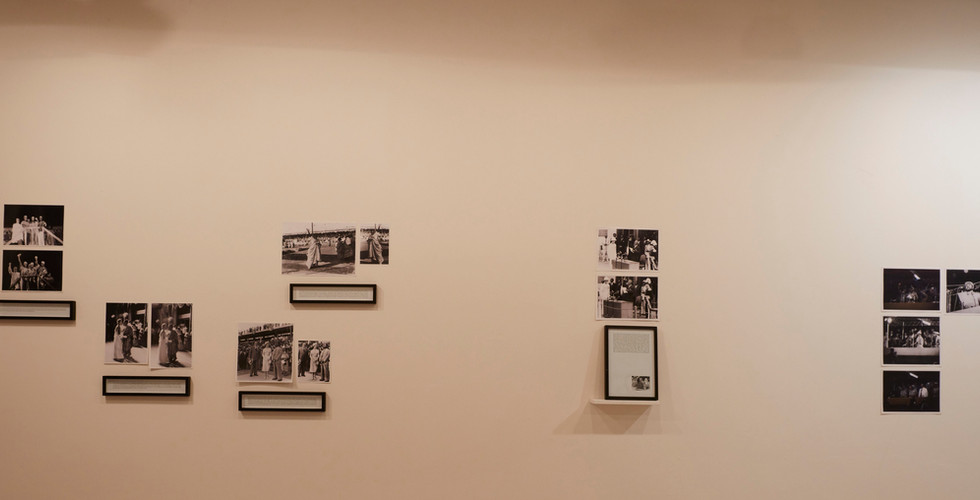“A warm data body is a portrait, not a profile; when a warm data body is erased, the real body remains intact.
Warm data is easiest to define in opposition to what it is not: warm data is the opposite of cold, hard facts.
Warm data is subjective; it cannot be proved or disproved, and it can never be held against you in acourt of law.
Warm data is specific and personal, never abstract. Warm databases are public,not secret.
However, warm data can only be collected voluntarily, not by force; the respondent always has a choice — whether to answer or not, which questions to answer, on what terms she will answer, and if her answers will be anonymous.
A warm database is distinguished from a corporate or government database not primarily by its interface or its underlying structure, but by the way its data is collected.”
Mariam Ghani
Mining Warm Data is a group exhibition of sculpture, installation, film and photography with roots in Sri Lanka, Myanmar, Afghanistan, India, Pakistan, Tibet, Nepal and Bangladesh. This show is inspired by the eleven-year collaboration making up Mariam Ghani and Chitra Ganesh’s Index of the Disappeared, whose newest chapter inhabits the central chamber of the show and brings the Index to South Asia for the first time. The works in this exhibition variously consider how an individual’s profile is defined through fantasy and subjectivity, beyond the traditional and clinical methods applied by statistical analyses, biometrics, government data agencies, economic interests, community interests, or even dictatorial censorship – “Assessment Work” to use mining terminology. Mariam Ghani’s definition of warm data is the central point on which these works revolve.
Warm bodies, cold bodies, and metamorphic bodies transitioning between these states challenge the viewer in this exhibition, which seeks to give agency to the spectator’s imagination rather than reduce the artworks to their often disturbing political implications. Some of the imagery in the show is viscerally disturbing such as the decomposing “body” Lost and Found (2012) by Huma Mulji; Minds to Lose (2008-2011) documenting Neha Choksi’s removal of warm mind from cold body by means of anesthetic; and the final writings of self-immolating monks in Last Words (2015) by Ritu Sarin and Tenzing Sonam. However, the works have not been selected for their shock value, rather they raise the emotional temperature in the space to enable us to feel the pulse of warm data, rather than the cold encounter of slickly packaged statistics. Except for deliberately suppressed material, such as that investigated by Amar Kanwar, shocking imagery circulates in the media to the point that it risks desensitising the viewer - how does this confrontation translate when this imagery confronts us in the emotional space that is art?
What is considered “true” depends on the story told rather than the evidence available, and data can be manipulated to tell different or even contradictory stories. Statistical data can be corrupted and skewed and statistical arguments can be used to assert falsehoods, something that warm data does not seek to do. We cannot ignore power dynamics within systems and, while in warm data we openly recognise biases, datasets have biases too, and statisticians work to remove the outliers (also known as bad actors, deviants, and contaminants) to prove their points. This statistical terminology also implies cold hostility to “points” that do not fit into the algorithm. Some statistical terms actually sound threatening: control group, finite population control, breakdown point, class boundary, rejection region... to name only a few. A person is more than the sum of the data points collected about them, although digital marketers trolling through the Internet might think otherwise.
Participating artists include Lida Abdul, Gazi Nafis Ahmed, Pablo Bartholomew, Neha Choksi, Hasan Elahi, Chitra Ganesh, Mariam Ghani, Hitman Gurung, S. Hanusha, Maryam Jafri, Dilara Begum Jolly, Amar Kanwar, Huma Mulji, Nge Lay, Nortse, Tenzing Rigdol, Menika van der Poorten and Ritu Sarin & Tenzing Sonam.
Tenzing Rigdol
Tenzing Rigdol, Monologue, 2014, courtesy of the artist and Rossi and Rossi. Photo courtesy of the Dhaka Art Summit and Samdani Art Foundation. Photo: Jenni Carter (from Mining Warm Data)
S. Hanusha
S. Hanusha, Installation view, 2015. Courtesy the artist and Saskia Fernando Gallery. Photo courtesy of the Dhaka Art Summit and Samdani Art Foundation. Photo: Jenni Carter (from Mining Warm Data)
Ritu Sarin and Tenzing Sonam
Mining Warm Data, Ritu Sarin and Tenzing Sonam, Last Words, 2015, courtesy of the artists. Photo courtesy of the Dhaka Art Summit and Samdani Art Foundation. Photo: Jenni Carter (from Mining Warm Data)
Huma Mulji
Huma Mulji, Lost and Found, 2012, courtesy of the artist and the Samdani Art Foundation. Photo courtesy of the Dhaka Art Summit and Samdani Art Foundation. Photo: Jenni Carter (from Mining Warm Data)
Chitra Ganesh
Chitra Ganesh, Black Sites I: The Seen Unseen, 2015-16, Installation shot of watercolour works. Courtesy of the artist and Gallery Espace, New Delhi. Photo courtesy of the Dhaka Art Summit and Samdani Art Foundation. Photo credit: Jenni Carter
Menika van der Poorten
Menika van der Poorten, The Real and the Imagined, 2015-2016. Courtesy of the artist. Photo courtesy of the Dhaka Art Summit and Samdani Art Foundation. Photo: Jenni Carter (from Mining Warm Data)
Amar Kanwar
Amar Kanwar, The Face, 2004/ Thet Win Aung, 2004/ Ma Win Maw Oo, 2004 (from The Torn First Pages, 2004–08), courtesy of the artist and Marian Goodman Gallery. Photo courtesy of the Dhaka Art Summit and Samdani Art Foundation. Photo: Jenni Carter (from Mining Warm Data)
Maryam Jafri
Maryam Jafri, Death with Friends, 2010, courtesy of the artist and Giorgio Persano Gallery. Photo courtesy of the Dhaka Art Summit and Samdani Art Foundation. Photo: Jenni Carter. (from Mining Warm Data)
Dilara Begum Jolly
Dilara Begum Jolly, Tazreen Nama, 2013, courtesy of the artist. Photo courtesy of the Dhaka Art Summit and Samdani Art Foundation. Photo: Jenni Carter. (from Mining Warm Data)
Hitman Gurung and Nortse
Hitman Gurung (left), I Have to Feed Myself, my Family and my Country (series), Collage of printed currency, 2013 courtesy of the artist and private collection, Heidelberg / Nortse (right), Prayer Wheel, Big Brother, Automan, 2007, courtesy of the artist and Rossi and Rossi. Photo courtesy of the Dhaka Art Summit and Samdani Art Foundation. Photo: Jenni Carter. (from Mining Warm Data)
Installation views
Maryam Jafri
Maryam Jafri, Installation view, 2012, Photo courtesy of the Dhaka Art Summit and Samdani Art Foundation. Photo credit: Jenni Carter (from Mining Warm Data)
Mariam Ghani and Chitra Ganesh
Mariam Ghani and Chitra Ganesh, Black Sites I: The Seen Unseen, 2015-16. Commissioned and produced by Creative Time Reports, the Juncture Initiative at Yale Law School and Samdani Art Foundation for the Dhaka Art Summit 2016. Courtesy of the artists, Creative Time Reports, the Juncture Initiative at Yale Law School, Dhaka Art Summit and Samdani Art Foundation. Photo credit: Jenni Carter (from Mining Warm Data)





















































